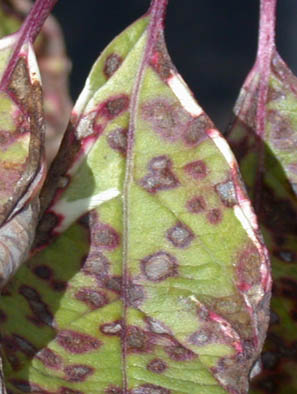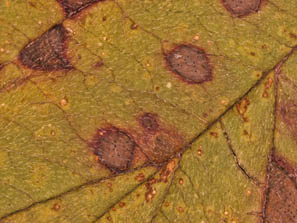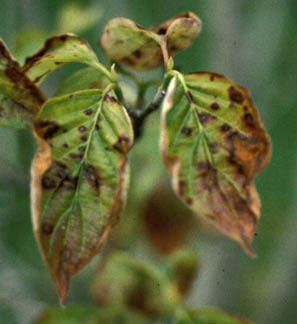Three Dogwood Diseases | |
|---|---|
| August 22, 2008 | |
|
In Illinois, we may see three foliar diseases of dogwood. All are fungal diseases: Septoria leaf spot, spot anthracnose, and Discula anthracnose. The first two cause aesthetic problems, but Discula anthracnose can kill branches and even entire trees. Fortunately, we do not see Discula anthracnose often in Illinois landscape settings. Spot anthracnose occurs in the spring and is caused by a fungus, Elsinoe corni. It affects flowers, leaves, young shoots, and even fruit. The spots are very small (about the size of the head of a pin), purple, and sometimes with a yellow center. Centers often drop out. The spots may merge to cause larger affected areas. This anthracnose disease is similar to those we experience on shade trees. Intensity is definitely related to the amount of moisture in the spring, in this case before or during flowering. Fungicide sprays are available to control this disease but would only be used where the problem is annual. Sprays are applied from bud swell through flowering. In Illinois, sprays are usually not needed. The disease may be severe when spring weather is particularly wet and cool during flowering, but sprays must be initiated before flowering. They work as preventives, not curative applications. Septoria leaf spot occurs near the end of summer and is visible now in Illinois. It is more common in wet conditions or high humidity. Several Septoria species may infect dogwoods. Purple spots, often with gray centers, occur on the leaves. These spots are larger than those of spot anthracnose, reaching about 1/4 inch in diameter.  Septoria has tiny, submerged fruiting bodies (pycnidia) that can be seen as black specks in the lesions.  Diagnostic spores are found within the fruiting bodies. No cankers are associated with the disease. Supposedly, stressed trees are more susceptible, but that does not always seem to be true on cases we have observed at the Plant Clinic. We do not usually recommend fungicide sprays to protect dogwoods from Septoria in Illinois. Discula anthracnose appears in Illinois in early summer (June), causing leaf spots similar in size to those of Septoria leaf spot, but without the obvious fruiting bodies. The leaf becomes blighted at the tip and edges.  Lower leaves are affected first. Discula anthracnose also causes stem cankers, killing shoots and contributing to the decline of the tree. Blighted leaves often remain attached to the dead twig, even into autumn. This disease is caused by Discula destructiva, aptly named. It is difficult to manage this disease. Keep dead wood trimmed out of your tree so that cankers do not move into the trunk. Remove the dead wood from the site and burn if possible. Water the soil around dogwoods in drought and use shredded bark mulch over the root system. Keep the mulch off the trunk. Fertilize in the spring or fall with a balanced fertilizer. High nitrogen levels may promote anthracnose. This disease is most likely to appear on trees in shady locations. It can be managed if caught early, before cankers invade large limbs. Many fungicides are registered for use against this pathogen. Sprays are applied in the spring to protect newly emerging leaves. Refer to the Illinois Commercial Landscape and Turfgrass Pest Management Handbook or the Home, Yard, and Garden Pest Guide for registered fungicides. | |
| Author: | Nancy Pataky |
